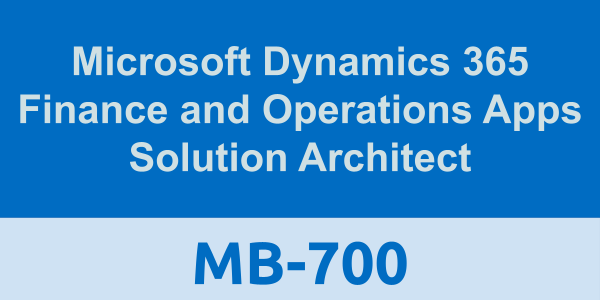Candidates for this exam are Microsoft Dynamics 365 professionals who advise stakeholders and translate business requirements into secure, scalable, and reliable solutions.
Candidates should have knowledge of the Dynamics 365 ecosystem and Microsoft Power Platform. They must have deep understanding of Dynamics 365 Finance, Dynamics 365 Supply Chain Management, Dynamics 365 Commerce, and Dynamics 365 Project Operations. In addition, they have extensive domain knowledge in one or more industry verticals. This role requires understanding how decisions affect the overall solution.
Microsoft Finance and Operations Apps Solution Architect Exam Summary:
| Exam Name | Microsoft Certified - Dynamics 365 Finance and Operations Apps Solution Architect Expert |
| Exam Code | MB-700 |
| Exam Price | $165 (USD) |
| Exam Price | 120 mins |
| Number of Questions | 40-60 |
| Passing Score | 700 / 1000 |
| Books / Training | Course MB-700T00: Microsoft Dynamics 365: Finance and Operations Apps Solution Architect |
| Sample Questions | Microsoft Finance and Operations Apps Solution Architect Sample Questions |
| Practice Exam | Microsoft MB-700 Certification Practice Exam |
Microsoft MB-700 Exam Syllabus Topics:
| Topic | Details |
| Architect solutions (20-25%) | |
| Gather requirements | - Identify operational and organizational challenges that may affect a business - Identify existing business processes and opportunities to optimize business processes - Gather information about expected transaction volume - Categorize business requirements and perform gap fit analyses - Review and validate business requirements throughout the solution lifecycle |
| Define the solution architecture | - Map business requirements to functional components - Evaluate whether to build versus buy for selected business requirements - Identify opportunities to implement supplemental Microsoft technologies - Use the appropriate implementation tools including Lifecycle Services (LCS) and Azure DevOps - Describe the Success by Design framework - Create solution architecture diagrams |
| Describe and document the solution blueprint | - Define an organization including company information, locations, and structure - Document the implementation timeline including roll-out strategies - Define the business process catalog and document solution gaps - Define instances, environments, and solution components - Identify required security roles |
| Define solution strategies (35-40%) | |
| Select a deployment strategy | - Develop a process to manage solution code and deployment - Select a deployment model and identify instances and environments required for the selected deployment model - Describe the One Version strategy for Dynamics 365 and the effects of One Version on solutions - Segment solution development and delivery into logical phases - Provide alternative methodologies and approaches for deploying modifications - Determine solution maintenance cadence and timelines - Identify upgrade scenarios and select appropriate tools |
| Define an application lifecycle management (ALM) strategy | - Define a code management and data flow strategy - Define a Microsoft Power Platform solution management strategy - Determine which build automation capabilities to implement - Define a roll-back strategy for solution code and data |
| Determine a data management strategy | - Differentiate between transactional and historical data - Define data quality and data validation process - Define data cleansing and transformation strategies - Define data dependencies - Develop a data migration strategy for master, transactional, reference, parameter, and document data entities - Develop data cut-over, verification and data retention plans |
| Define the security architecture | - Differentiate between Azure, Dynamics 365, and infrastructure security - Describe Azure and infrastructure security-related elements - Describe use cases for and capabilities of record-level and role-based security in Dynamics 365 |
| Define the integration architecture | - Select an integration pattern including OData, Microsoft Power Platform integration, Batch Data API, customer service, external web services, and office integrations - Identify required integration and interface details - Design integrations - Define an integration testing strategy |
| Define the business intelligence and reporting architecture | - Gather business intelligence and reporting requirements - Define data sources required to meet business intelligence and reporting requirements - Select appropriate business intelligence and reporting tools including Power BI, organizational workspaces, financial reports, SQL Server Reporting Services (SSRS), and the Electronic Reporting tool - Define printing requirements including, Document Routing Agent (DRA), modern report design layout templates, check printing, and label printing |
| Manage implementations (20-25%) | |
| Describe Lifecycle Services (LCS) tools | - Understand the use cases and capabilities of different LCS tools - Understand the use cases and capabilities of Business Process Modeler (BPM) - Understand the use cases and capabilities of LCS Methodologies - Create a usage profile to describe current or projected usage |
| Manage interactions with FastTrack | - Identify the value proposition for FastTrack - Identify FastTrack engagement types and personnel roles - Describe typical types of FastTrack workshops and the inputs for each workshop - Describe go-live checklist elements |
| Determine support options | - Develop a support plan and strategy - Define post-go-live support plans including response times and service-level agreements (SLAs) - Describe use cases and capabilities for the LCS Support tool |
| Determine licensing requirements | - Determine the types of licenses required - Estimate the number of licenses required by using the License Sizing estimator - Describe the process for estimating ongoing software licensing costs |
| Manage testing (10-15%) | |
| Define a testing strategy | - Define a testing strategy that includes all required types of testing - Define a regression testing strategy - Identify opportunities for automated testing - Review use cases and test coverage for business scenarios - Determine when to use RSAT, SysTest, Postman, ATL, Azure Devops Test Plans, and other tools |
| Define a performance testing strategy | - Define performance goals and requirements - Identify performance monitoring and testing tools - Define performance benchmarks and success criteria - Design a performance and load testing strategy - Troubleshoot performance issues |





0 comments:
Post a Comment